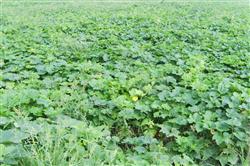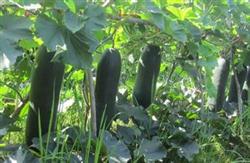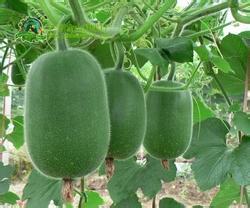Management of wax gourd fruiting period in open field

As the wax gourd fruiting period in the open field is in the high-temperature and rainy season, the setting rate of wax gourd is low and the melon-melting phenomenon is serious. The following six main points should be mastered in management: first, pollinated wax gourd has no unisexual fruiting habit, and artificial pollination can greatly increase the setting rate of winter melon. The method is to select the newly opened male flowers in the morning, remove the Corolla, expose the anthers, and smear on the female flower stigma. Pay attention to let the stigma pollinate more. The time should be before 8 a.m. and no later than 10:00 at the latest. The flower stalk can also be smeared with 15020mg / kg 2Jet 4murd. Second, remove the lateral vines in time, because each leaf axil of wax gourd can grow a lateral vine, and the growth rate is fast, and the consumption of nutrients affects sitting melons and fruiting melons, so you should generally break lateral vines every other day. Third, hit the top wax gourd after sitting on the melon, leave 7 to 10 leaves in front of the melon to hit the top, in order to concentrate nutrients to supply the sitting melon. Fourth, if the change of head is due to excessive base fertilizer, the main vine caused by too much Rain Water can be changed if you can't sit still. That is, when a wax gourd with the size of peanuts grows, you can leave 1 or 2 leaves in front of the melon to knock off the top. When the axils of the top leaves grow into lateral vines again, they can be left as the main vines. In this way, you can sit on the melon by changing it for 1 or 2 times. 5. Fertilizer and water management in the early stage of melon formation, when the melon grows to about 250 grams, available phosphorus and nitrogen fertilizer can be applied once with the water, and diammonium phosphate and urea can be applied each of 7 to 8 kilograms per mu. When entering the melon harvest period, water was watered every 15 to 20 days, and chemical fertilizer was applied with water flushing, applying diammonium phosphate and urea per mu of 7 kilograms and 8 kilograms respectively. In the middle stage of melon, the daily growth is larger, plant transpiration and soil evaporation are larger, so it is necessary to continuously supply water. Generally, water should be irrigated once in 7-10 days, and potassium sulfate 7-8 kg and urea 5-6 kg per mu should be irrigated with water. Watering in the later stage should be diligent and light. Master watering once every 5-6 days to keep the soil moist. In the later stage of plant growth, 0.2% potassium dihydrogen phosphate plus 0.5% urea aqueous solution can be used for foliar topdressing to supplement nutrition. 6. the main diseases of wax gourd are Fusarium wilt and powdery mildew, and the main insect pests are aphids. 1. Powdery mildew: strengthen cultivation management, reasonable watering and fertilization; at the initial stage of the disease, you can use 1500 times of the wettable powder or 300 times of 400 times of 50% sulfur suspension, spraying once every 7 days or so. two。 Fusarium wilt: 3-5-year crop rotation; soil disinfection; at the initial stage of the disease, root irrigation with 500 times of 50% carbendazim wettable powder, 200 ml per plant, once every 10 days, 2-3 times in a row. 3. Aphids: you can choose parasite, Lesbon or kill, spray once every 7 to 10 days, twice in a row.
- Prev

High-yield cultivation techniques of Green skin Wax Gourd
Green-skinned wax gourd is widely cultivated in North China, with strong adaptability, high yield, storage tolerance and transportation. The high-yield cultivation techniques are introduced as follows. First, sowing and raising seedlings 1. Seed treatment. Wax gourd seeds are not easy to absorb water because of their thick seed coat, so seed soaking and seed disinfection should be carried out before sowing. Use more than 50% carbendazim 25.
- Next

Grafting cultivation of small wax gourd
First, hotbed seedling selection of wax gourd and cucumber seeds, soaked in light salt water and disinfected, respectively planted in the hotbed. After emergence, uncover the shed to refine the seedlings and pay attention to watering. Timely grafting when the above two kinds of melon seedlings have a real leaf to unfold, the melon seedlings will be pulled up by the roots and grafted by the grafting method. Use a knife in the middle of the stem of the melon seedling.
Related
- Where is it suitable to grow horseradish in China? it is expected to see the middle altitude horseradish in Alishan.
- How to prevent tomato virus disease reasonably? (Control methods included)
- Many people like to plant towel gourd on the balcony. What are the main points of this method and management?
- What crops can chili peppers be mixed with?
- Fertilization techniques and matters needing attention in Tomato
- What are the grafting techniques for peach seedlings in spring?
- Harm and control methods of root swelling disease of Chinese cabbage
- What are the pests of sweet potatoes? How to prevent and cure it?
- Symptoms, causes and Control methods of navel Rot in Tomato
- The cause of "Cucumber rotten bibcock" in Farmers' planting Cucumber and its Control Plan

